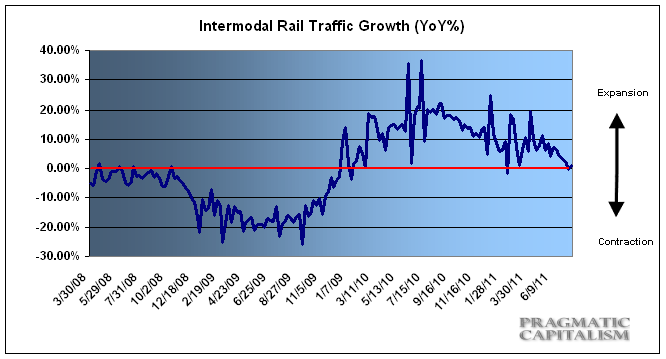The recent downtick in rail traffic data is consistent with most of the macro data we’ve been seeing over the last few months. The US economy is slowing, but still growing marginally. The latest weekly reading from the AAR showed a 0.3% decline in total carloads and a 1.2% climb in intermodal traffic. 28 weeks into the year total carloads are up 2.4% while intermodal is up 7.2%. The AAR reports:
“The Association of American Railroads (AAR) today reported mixed results for weekly rail traffic, with U.S. railroads originating 281,387 carloads for the week ending July 16, 2011, down 0.3 percent compared with the same week last year. Intermodal volume for the week totaled 230,324 trailers and containers, up 1.2 percent compared with the same week last year.
Fourteen of the 20 carload commodity groups posted increases from the comparable week in 2010, including: iron and steel scrap, up 34.8 percent; metals and products, up 18.7 percent, and petroleum products, up 18.3 percent. Groups showing a decrease in weekly traffic included: waste and nonferrous scrap, down 17.3 percent; coal, down 6.7 percent, and primary forest products, down 5.8 percent.
Weekly carload volume on Eastern railroads was up 0.1 percent compared with the same week last year. In the West, weekly carload volume was down 0.5 percent compared with the same week in 2010.
For the first 28 weeks of 2011, U.S. railroads reported cumulative volume of 8,066,188 carloads, up 2.4 percent from the same point last year, and 6,279,076 trailers and containers, up 7.2 percent from last year.”

Source: AAR
Mr. Roche is the Founder and Chief Investment Officer of Discipline Funds.Discipline Funds is a low fee financial advisory firm with a focus on helping people be more disciplined with their finances.
He is also the author of Pragmatic Capitalism: What Every Investor Needs to Understand About Money and Finance, Understanding the Modern Monetary System and Understanding Modern Portfolio Construction.
